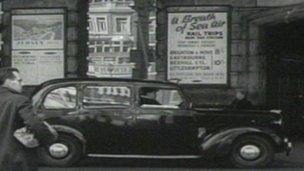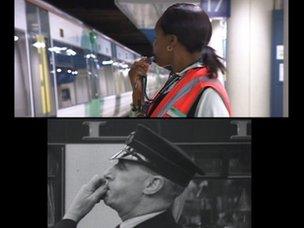London to Brighton non-stop: Tracking the changes to a seaside rail journey
- Published
The BBC filmed the journey in 1953, 1983 and again in 2013
Hard-pressed commuters would no doubt jump at the prospect of a non-stop train service from London to Brighton - especially if there was a good chance of getting a seat.
But there was a time when passengers - they were not "customers" then - really could enjoy that luxury.
The BBC filmed that journey back in 1953 when passengers could travel the entire route without stopping.
Thirty years later it repeated the exercise, observing the changes in the intervening time.
Now I've retraced that trip, 60 years on.
Social barometer
Only this time Southern Railway had to lay on a special train for us to compare the three journeys through the magic of time-lapse filming, for there are no longer any non-stop trains between London and the south coast.

Passengers in 1953 could make a non-stop journey from London to the south coast
And because the railway now is so busy, it could only be done early on a Sunday morning.
The result is a fascinating social barometer, as well as a record of how the railway itself has changed.
Now every train from Victoria to Brighton stops at least once on the route.
To the casual observer the journeys look remarkably similar when placed side by side.
Most of the bridges, and many of the platforms, remain the same.
Pullman service
But by 1983 and 2013 there was far more trackside vegetation - in the steam era trees were cut back to reduce the risk of fires from hot ash.
In the first film, a clerk checked tickets as passengers arrived for the Pullman service.
Staff still checked tickets manually in the 1983 film.
Today, passengers push tickets into automatic barriers.
In 1953 every railway worker was male. Today, many of the platform staff are women.
The 1953 train had a top speed of 75mph. Today they can do 90mph.

Railway staff featured in the 1953 film were all male, unlike today
The original journey took an hour non-stop. Now, even with two stops, the fast trains to Brighton complete the journey in 52 minutes.
But is it better value for money?
Rail magazine's fares and timetable expert Barry Doe says 60 years ago a return ticket cost 15 shillings (75p), about £18.75 today.
An "anytime" return ticket now, at £28.80, is around a third more expensive - but based on an average weekly wage of £9.30 in 1953 and £447 today, that's a slightly smaller proportion of earnings.
Now there are twice as many trains and more than double the number of passengers squeezing into the air-conditioned carriages.
But perhaps the most obvious change is in the clothes people wear.
In the 1950s film passengers are soberly dressed.
By the 1980s Brighton style has become more relaxed, but still most men wear suits and ties.
Come August 2013, the railway staff are more cosmopolitan, still more relaxed and the uniform less rigid, with open-neck shirts.
The Brighton passengers are fatter and slower on their feet 60 years on.
And as for their fashion, well, anything goes.
- Published25 April 2013
- Published9 December 2011